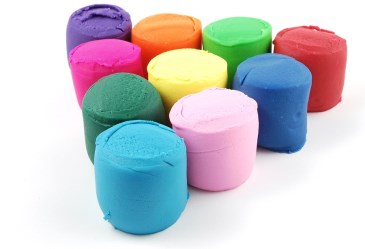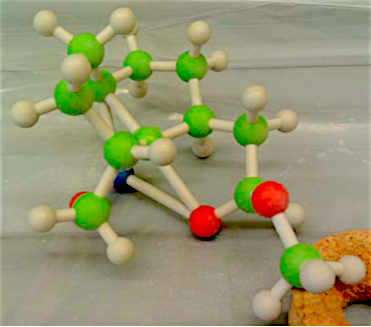Molecular Visualization
Throughout my years of research and study, I have kept a ball and stick molecular modeling kit on hand. It proved very helpful for learning chemical structures during my education. They are particularly useful for more simple structures that contain smaller numbers of atoms (<100 atoms).
As I progressed into more specific fields of study and research, I worked with molecules and compounds that were too large to be modeled with a modeling kit. For example, my HP Urease project focused on complex protein structures. To approach this structure, my access assistant and I made a model with vibrantly colored Play-Doh to utilize the remaining vision in my left eye (I can see bright, well-saturated colors), placing emphasis patterns and general shapes as opposed to individual sequencing. By keeping Play-Doh on hand, I had a tactile model that I could readily explore and refine.

In some instances, I have also used pipe cleaners and tasked my access assistant with making a model. Pipe cleaners provide a cheap solution to build very complex chemical structures.
Looking to the future, I am very interested in 3D printing. A friend and fellow blind chemist, Dr. Henry Wedler, has spent time developing a method to print molecular models and modeling kits that include Braille labels for things like atom identity, bond lengths, and bond angles. Dr. Wedler has co-authored an article in the Journal of Computer-Aided Molecular Design that demonstrates the ways in which 3D printing can aid a visually-impaired researcher. The article can be found at this link. He has also made a PowerPoint presentation detailing 3D printing strategies, which can be found here. I am hopeful that models like these will become widespread in the education of blind students, and I am looking into the possibility of incorporating this technology into my own daily research.

3D printing has also been made more accessible by the availability of 3D printers and the development of the NIH 3D Print Exchange. The Print Exchange generates files that are compatible with 3D printers, utilizing structures from the Protein Data Bank or your own file. The Print Exchange also allows users to share files with each other and has resources to help you create your own custom models. Click on this link to find out more: https://3dprint.nih.gov/
Being visually-impaired means you need to depend on your memory more than a sighted researcher. If you’re not sure about something, you can’t just glance over to check.
Memorizing things like large protein structures can be very daunting. I approached this by dividing the protein into manageable chunks first, and then gradually adding more details. The protein that I studied for my thesis had twelve identical parts. Distinguishing the different sections by color with Visual Molecular Dynamics allowed me to gain a better understanding of how the pieces fit with one another. When I had a general idea of how this protein looked, I was able to slowly fill in finer detail. Using play-dough models, I was eventually able to become so familiar with the placement of different structures in the protein. In the end, I had nearly the entire peptide sequence memorized so well that I could identify the location of almost any amino acid residue.